Part II: 1960 to 1985
At the beginning of the 1960s, Dr. Malcolm Love continued his successful Presidency of SDSC. His tenure was from 1952 until 1971. The year of his retirement was marked by the opening of the Balboa Naval Hospital Speech Clinic, a very successful collaboration between the administration and Speech Pathology and Audiology strand of San Diego State College, the United States Navy, Balboa Naval Hospital, and the Naval Reserve Officers Wives. More about that later. In 1960, SDSC awarded M.A. degrees in 14 fields and 30 areas, and M.S. degrees in eight.1 A branch of SDSC had been established in the Imperial Valley in the 1950s, further increasing research and publications. Since President Love had created the first faculty Senate in the state colleges of California in the 50s, faculty now played a larger role in San Diego State’s planning. The Senate advised the President, and there was strong collegiality on campus. The major change took place in July, 1961, when the newly formed Board of Trustees of the recently legislatively mandated California State College System met for the first time. Where did they meet on that momentous occasion? At San Diego State College, regarded as the jewel of the system even in 1961.2 Now, all of the state colleges were connected in a kind of federation, with an appointed Chancellor of the system. The college Presidents reported to the Chancellor’s office in Long Beach. The first Chancellor was Buell Gallagher, and he was succeeded by Glenn S. Dumke, who served in that post for many years.3
 Open the image full screen.
Open the image full screen.
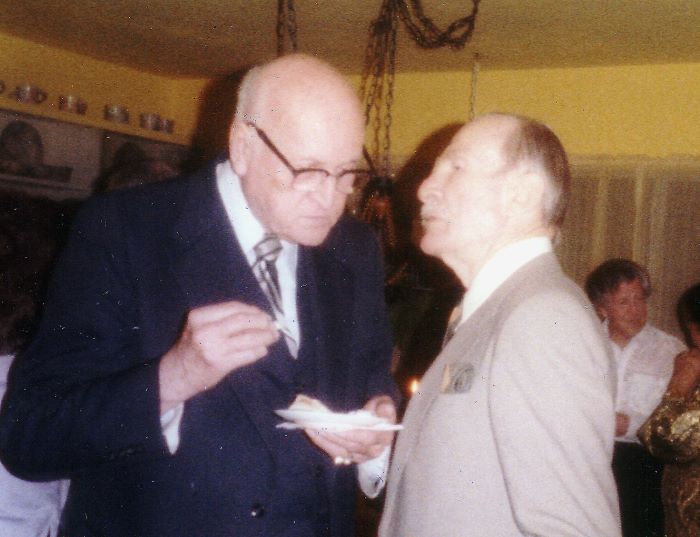 Open the image full screen.
Open the image full screen.
1963
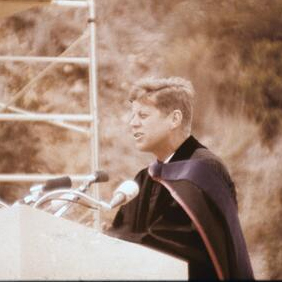
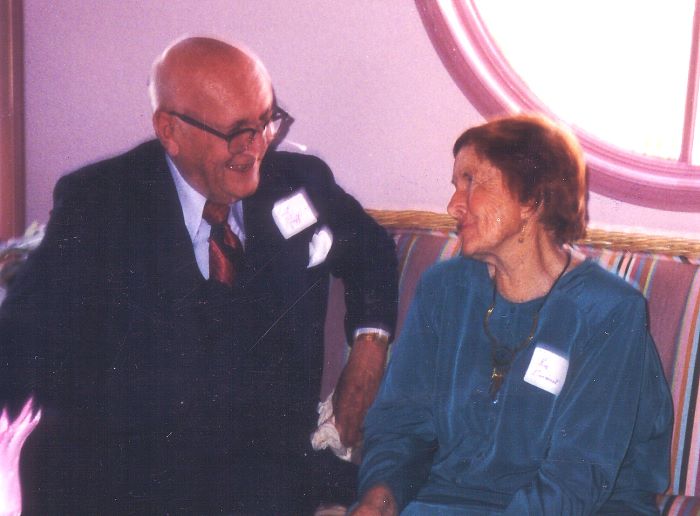 Open the image full screen.
Open the image full screen.
1964
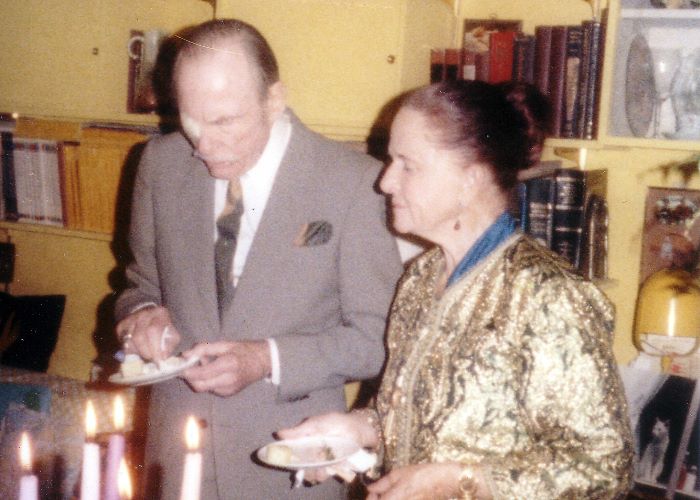 Open the image full screen.
Open the image full screen.
 Open the image full screen.
Open the image full screen.
Jo Cormier recalls serving on a committee with Dr. Earnest charged with hosting a very large professional conference in San Diego at the Marine Corp Recruit Depot in 1962. The final gathering of that successful event was held at the MCRD Club.
The 1960s graduated students in speech Pathology who went on to achieve national prominence in the field. Among them were John Saxman, Jon Miller, and Donald Morgan, all later earning their doctorates and establishing eminent careers. Actor Cleavon Little earned a degree with emphasis in Speech and Hearing Pathology, but did not pursue that field. Instead, he studied at the National Academy of Dramatic Arts and experienced great success on the Broadway stage and in movies.
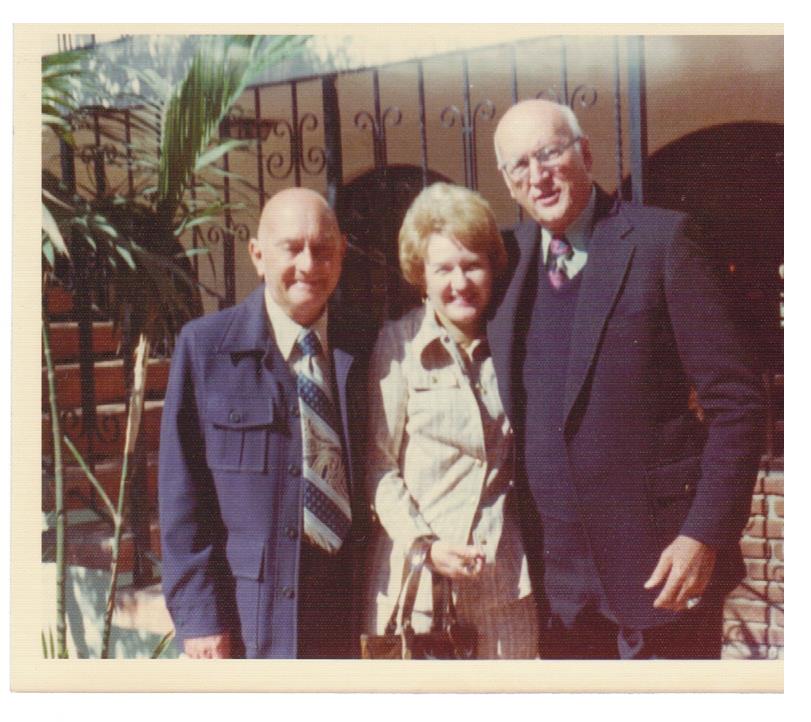
Throughout the period covered in Part II of the school’s history, all faculty, full-time and part-time, whether Professors or Lecturers, spent many hours advising, tutoring and mentoring students. Full-time faculty had a requisite number of students officially assigned to them to advise. But, non-tenure-track and part-time instructors advised students also. It was an essential element in instructing and training future clinicians, teachers and researchers.
Alan Nichols, Ph.D., joined the faculty in 1964.13 He had previously taught at the University of California Santa Barbara, and his area of specialization was voice. He also taught and published in areas of articulation and laryngectomy. Dr. Nichols chaired many Master’s thesis committees. Like all other Ph.D. faculty, he also served as second and third members on thesis committees. Non-Ph.D. faculty did not chair theses, but served as second and third thesis committee members. Like Dr. Pfaff before him, Dr. Nichols had an excellent speaking voice and utilized it not only in speech therapy and research, but in local stage performances. This is a reminder of the origin of the field of speech pathology, later Communicative Disorders, and now Speech, Language and Hearing Sciences. As noted in Part I of this history, dramatic Arts played a strong role in the genesis of the field, along with education, psychology, and neurology.
1966
A full front page of the San Diego Union was devoted to SDSC’s involvement in the annual conference of the California Speech and Hearing Association held at the El Cortez Hotel in March, 1966.14 Four large photos were featured on the page with lengthy text about the event and the field of speech and hearing, and the piece extended to an inside page. Faculty member Alan Nichols and his wife Janet appeared in one picture, while Marilyn Marston, faculty member Marcia Harris (Mrs. Saul Harris as identified in the photo–women were noted by husbands’ name preceded by Mrs.—a sign of the times), and Val Robbins in another. A third photo of committee members featured Mr. (Dr.) Richard Riedman, Mrs. Bob Langley, Mrs. Robert Nemitz, and Patricia Earnest (Dr. Earnest’s daughter who was a speech therapist in San Diego City Schools). The photo caption noted the committee meeting was held in the home of the California Speech and Hearing Conference Chairman, Dr. Sue Earnest. Mr. Stuart Yarborough, Mrs. Howard Hawkinson, and (Miss) Barbara Billey were shown admiring dresses from Oaxaca in preparation for the conference. That the culture of Mexico would be highlighted during the conference was not at all surprising for several reasons: San Diego is situated at the southwestern tip of the United States on the border of Mexico; “Dr. Sue” had a lifelong interest in Mexico, traveling throughout it during her lifetime and, for many years, maintaining a second home in the La Playas area of Tijuana, Mexico; emphasis on multiculturality had developed very early in SDSC’s history. Painter/teacher Everett Gee Jackson had spent lengthy periods of time working in Mexico, as had art faculty member Lowell Howser. When Robert Lee was told what noted sculptor and SDSC art Professor, John Dirks, had answered to the earlier question “Why do you think so many talented people came to the state?,” “the weather, of course,” Lee added, “and the close proximity of Mexico.”15 San Diego’s story was intricately entwined with that of Hispanic culture as well as the indigenous Indian tribes.
The first joint Doctorate was offered at SDSC in 1965, and this is particularly important because the model of the joint Doctorate (initially between SDSC and the University of California San Diego, but later jointly awarded with Claremont Graduate School, also) was the one adopted when the SDSU/UCSD Joint doctoral program in language and communicative disorders was established.16
1967
Faculty publications increased in 1967, particularly from Drs. Riedman, Nichols, and Ouellette. The same year, there were 66 students in training. The California State College fee system was approved at this time, also.17
Dorothy Baronofsky served as a Lecturer during the 60s. She was well connected to the community, serving on important boards of medical and social service agencies. A vibrant and cheerful woman who was married to a noted San Diego M.D., she provided encouragement and supervisorial skills for students. During these years, as well as the next three decades, Dr. Thile successfully blended his full time teaching and clinical directing skills with his private practice, resulting in strong clinically based methodology. He was a popular lecturer and he continued to counsel parents of children with speech and hearing needs.
The first Graduate Teaching Assistant position in the Department of Speech Pathology and Audiology was established in early 1962. That position was filled by Darlene Gould in Fall, 1962. Thus, Gould became the first Graduate Teaching Assistant in the department, and held that post through spring 1965. Through the many following years, additional Graduate Teaching Assistant positions were added to the one created in 1962. Marcia Harris taught courses and supervised clinicians during this period.
In terms of the entire SDSC campus, “The number of African American students increased from about 50 in 1967 to over 600 in 1970” according to Raymond Starr. 18 Cleavon Little, an African American, referred to earlier, as a student of Audiology completed the program in the early 1960s.
1971
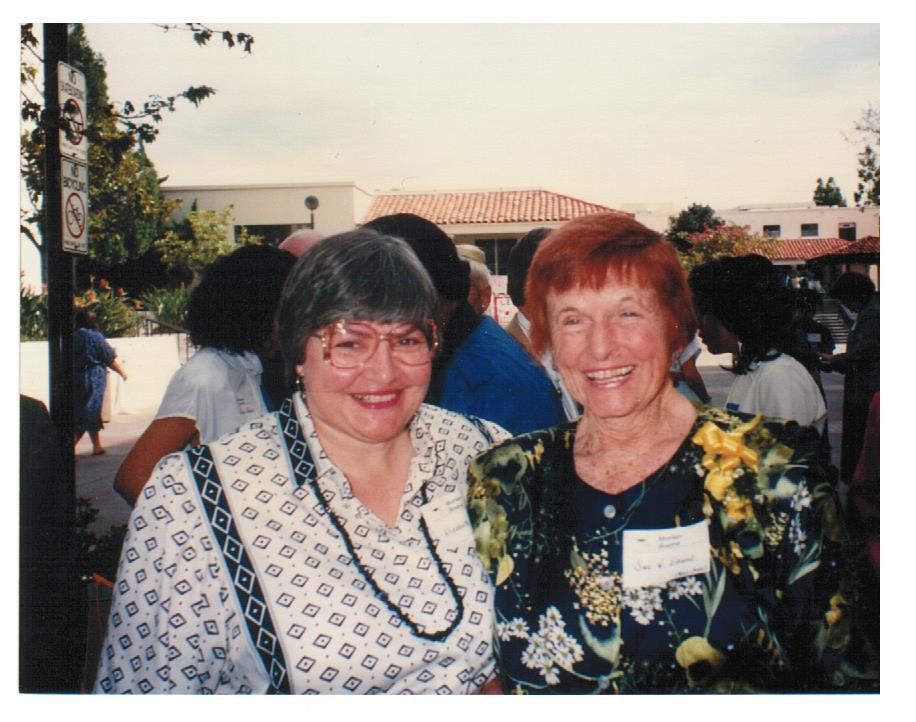
Throughout the 60s and early 70s, Speech Arts faculty continued to teach the required Oral Communication course, which was a general education requirement for all matriculating SDSC students. That meant some instructors from each of the four strands taught this basic course. This was in keeping with the college emphasis on speech and written communication. While speech pathology and audiology gained strength and complexity, creating more specialization, Oral Communication still ensured employment for instructors. That changed in future decades when basic public speaking training was sited in the major of rhetoric and public address, and even later, in the School of Communications.
The Balboa Naval Hospital Speech and Language Clinic came to fruition in 1971. Its story is one of volunteerism in partnership with government, both state and federal. It is not certain that what was accomplished in 1971 could be replicated today, in 2011. In 1971, the Naval Reserve Auxiliary was formed by a group of women who wanted to do more than socialize during reserve drill days. They wanted a purpose. So, they conceived the idea of forming a speech and language clinic at Balboa Naval Hospital. Balboa Naval Hospital was large and very well known, but it lacked facilities and services for active duty and dependents who had communication difficulties. A member of the new Auxiliary was Jo Cormier, fondly referred to as Jo and the same Jo who served as the second speech clinic technician at the SDSC clinic from 1962-65. She was a speech pathologist with a long history of work with the San Diego State College Speech Clinic and with the San Diego public schools, where she served children with communication impairments. She was also a good friend of Dr. Earnest. This was an irresistible combination. At the time, there were 2000 members of the Naval Reserve. There were also only two facilities available to the military then, in Bethesda, Maryland and in Oakland, California. As Lucille Heard remarks in her unpublished paper, “It was the Navy’s protocol to relocate patients and sometimes, but not always, their families to one of these two locations for treatment. With such a large military community in San Diego and with the potential location of Balboa Hospital, the need was apparent for a local clinic.”19
1972
Cormier had noted that, over the years, numerous calls came to the SDSC Speech Clinic for help for children in Navy families because there were no services for them at Navy Hospital. Cormier met with Dr. Sue, then Chair of the Speech Pathology department at SDSC, and they decided to contact Admiral Joe Williams, Commandant of the 11th Naval District, which covered the California, Nevada and Arizona. Admiral Williams was enthusiastic about the project and ultimately spearheaded the drive for the establishment of the clinic. From the beginning, he was cordial and offered to see what could be done, despite limited space at the old hospital in Balboa Park. Rear Admiral Horace D. Warden was Commanding Officer of Balboa Naval Hospital at the time. After several meetings and no progress, the plan came to the attention of Dr. Robert Cantrell, ENT department head at Balboa Hospital, who eagerly welcomed the program, saying “We need your services and we will provide you the space you require somehow.” With the support of Dr. Cantrell, Rear Admiral Warden and the United States Navy, the clinic was launched in 1971, though it was formally dedicated on February 9, 1972.20 At the dedication, it was noted the clinic operated three afternoons a week, servicing 200 diagnostic and therapy consults a month. An announcement to this effect appeared in the San Diego Naval Reserve News shortly thereafter, and it was announced in the same publication “It is the hope of the auxiliary to expand the services and that it will be operated on a full-time basis soon.”21 The Auxiliary provided money for all equipment, diagnostic, habilitation and rehabilitation materials. These women typed all clinical reports regarding clients, made appointments, answered phones, gave directions, decorated the clinic for special occasions, and shopped for all required items. Their support was not only remarkable, but essential. Truly, there would have been no speech and language clinic without the services of these women. Indeed, the large, sophisticated clinic which operates as a regular part of the Balboa Naval military hospital today might not exist today without the work of that auxiliary. A contract with SDSU provided graduate students on externships to conduct therapy, supervised by SDSU faculty and the clinic director/supervisor, who was also a part-time lecturer at SDSU. Dr. Thile traveled to Naval Hospital to supervise a clinical section of stuttering clients. Likewise, Drs. Allen and Nichols supervised training clinicians working with cleft palate, articulation and voice clients. The Director/Supervisor was paid $400 a month by the auxiliary, which regularly held fund raisers for their project.22 After three years of struggling to find funds for the clinic, the auxiliary was relieved of this pressure when Dr. Cantrell announced he had found a source of funding by the Navy Department’s Bureau of Medicine. The timing was propitious because it was around this time that the Navy Department announced a reduction of Naval Reserve forces by more than half.23 The reduced number of auxiliary members, therefore, could not help as much, though there was a stronger than ever need for services. The Navy was now totally funding the clinic, but auxiliary membership was not large enough to provide volunteer services. At that point, Katherine Rogerson, the Navy Officers Wives Club President offered to sponsor the clinic, thus replacing the Naval Reserve Auxiliary of those duties.
A 1973 story in the San Diego Union about the clinic featured a photo of Mrs. Rogerson, wife of Admiral Rogerson with supervisor Gould and a young five year old client. The same Mrs. Rogerson, as President of NOWC, offered sponsorship of the clinic a year later in 1974. NOWC has continued to support the clinic to the present time. The steady progress and ultimate success of the Balboa Naval Hospital Speech and Language Clinic provided a model for formation of other contracted college externships with surrounding medical facilities in later years, such as the Veterans Administration Hospital, Kaiser Permanente and the University of California San Diego. Students had been placed at external facilities for training before the Naval Hospital agreement, but not in legally drawn contract relationships. There was now an established prototype. In future years, graduate students would have opportunities to develop specialty clinical skills in an array of fine medical facilities and private practices.
In the same year of the creation of the Balboa Naval Hospital Speech Clinic, 1971, the American Indian Studies Department laid its foundation. According to Raymond Starr on page 184 of his SDSU history book, it “featured both academic and support programs on campus, as well as connections with the off-campus Native American community.” (Starr, p. 184) The year before, 1970, the Women’s Studies program began to offer classes. This was the first women’s studies program in an institution of higher learning in the United States. All of the enlightened movements of the 60s and 70s decades, African American, Native American, Chicano, and Women’s Studies, contributed to the enlarged awareness of diversity. The studies of Speech Pathology and Audiology also were enriched by greater knowledge and awareness.
1973
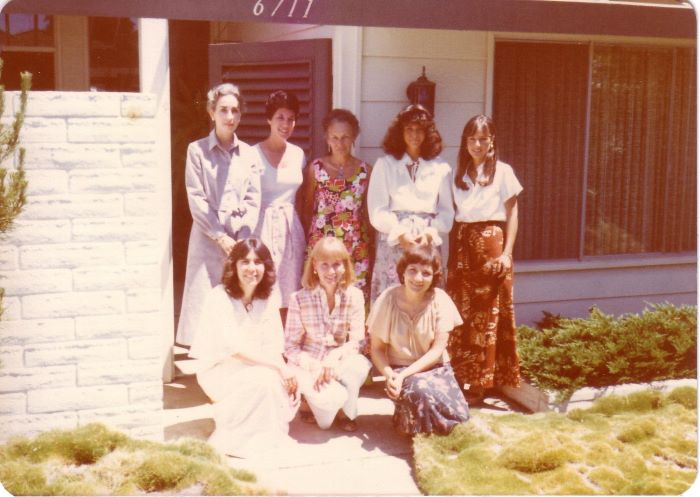 Open the image full screen.
Open the image full screen.
The four areas of Speech Arts officially separated in the early 70s. This acknowledged what had been a functional fact for some time. The next administrative challenge came in 1978, when speech, language and hearing left the very large College of Professional Studies to join other disciplines in formation of the new College of Health and Human Services. Constituent members of the new college were the Department of Communicative Disorders, the School of Nursing, the School of Social Work, and the recently formed Graduate School of Public Health. The first Dean of the College of Health and Human Services was Dr. Harry Butler. Upon his departure, Dr Harriett Kopp succeeded Dr. Butler as Acting Dean in 1980. Then, Dr. Peter Dual became Dean in 1983, and Dean Dolores Wozniak assumed the post in 1994. Meanwhile, the matter of the permanent name of the college was still being debated and had to be settled. There was endless discussion of possible suitable names for the new college at faculty meetings. Eventually, the title of Health and Human Services was arrived at, based on the national model of the Department of Health and Human Services in Washington, D.C. The formal name of the college was changed to the College of Health and Human Services in 1986, “to reflect the College’s expertise and programs focused on a variety of health and human services.”24 Four distinct objectives were formulated as part of the new college’s mission. They were:
- Assist students through education and leadership education to become caring professionals.
- Provide community education concerning the sometimes dire circumstances under which large segments of our society live.
- Educate non-majors in the University about the identification, intervention and prevention of health and human/social problems by offering General Education courses.
- Provide avenues for life-long learning by the dissemination of new knowledge and technology which emanates from research and which has the power to influence parents.
Speech-language Pathology and Audiology state licensure was mandated in 1974. The regulation section entitled Article 3. Licenses stated, “On or after July 1, 1974, no person shall engage in the practice of speech pathology or audiology or represent himself or herself as a speech pathologist or audiologist unless he or she is licensed in accordance with the provisions of this chapter.”25 “SDSC faculty and San Diego area speech therapists traveled to Los Angeles to take the state examination. California state licensure continues to be administered through the California Department of Consumer Affairs.
“In 1971 the legislature finally acted, and in 1972 State officially became ‘California State University, San Diego.’ State, however, was not happy at having its identity submerged under the name of the system so it continued fighting. Finally, on 1 January 1974, officially became what it had long called itself: ‘San Diego State University.”26 San Diego State was the first in the state college system to achieve the title of university. More name changes were ahead. The department name of Speech Pathology and Audiology would later change to Communicative Disorders.
Alumna Sheila Lipinsky earned her Master’s degree in Deaf Education in 1971, and then helped establish a specially designed program for hearing impaired children in the public schools. She has remained closely allied with what is now the SSLHS. Lipinsky was later honored as an Outstanding Alumna and was presented a Monty.27
1975
The SDSC Speech and Hearing Clinic continued to receive excellent publicity in the San Diego Union. On April 6, 1975, the Union ran a front page article titled “Stutterers Learn to Talk it Out.” The article by Noel Osmont featured two photos of San Diego State Graduate Clinicians, one Carol Kelly with a young child, and a second one of Audrey Recchia working with an adult. The informative story about stuttering and State’s treatment of stuttering ran on two pages of the newspaper, and it delved into various theories regarding the causes of stuttering. It was well written and told some of the clinic’s story.28 Of course, positive community relations resulted in a predictable increase in inquiries from the public regarding services. That was good. It provided education and provided a bridge between the clinic and the public.
In the same year of 1975, the Union ran an article headlined “It’s Not What You Say, It’s How You Say It At Speech Clinic,” authored by staff writer Lucretia Steiger. It, too, ran over to the second page, and provided an overview of the field of communication, explaining when speech and voice behaviors become problems, what defines atypical speech. The piece discussed many types of cases treated in the clinic, and was a useful introduction to the field. The article was accompanied by three photos of SDSU clinic student Tina Weller performing speech exercises in the clinic.29
Carolyn Scott served as the first Clinical Coordinator of Clinical Services for Speech for a couple of years, but left the faculty in 1976. Three Coordinator of Clinical Services positions were created to facilitate more efficient and comprehensive services in specific discipline clinical services. In addition to Carolyn Scott, Diane Williams, who joined the faculty in 1975, assumed the role of Coordinator of Clinical Services for Audiology, as did Sally Wood for Deaf Education. Williams previously taught and supervised in both the Audiology and Deaf Education programs. In 1976, Darlene Gould assumed the coordinator position in Speech Pathology, replacing Carolyn Scott. Gould left the supervisory position at Balboa Naval Hospital to do so. Francine Austerlitz, a part-time supervisor at San Diego State, then became chief supervisor at the Naval Hospital. Additional part-time clinical supervisors augmented the clinical training program. Robert Novak, Ph.D., an audiologist, joined the faculty in 1977. Dr. Novak’s appointment strengthened the audiology strand, as he worked with Dr. Riedman and Diane Williams, who were already full-time faculty. Arleen Kagen and Marilyn Lonky were valuable part-time additions to the deaf education faculty in the 70s.
1976
The newly mandated Communication Handicapped teaching credential was written and adapted for San Diego State University by Clinic Director Thile and the three Clinical Coordinators. This was undertaken in 1976 and completed in 1977. The department awarded many specialist credentials to teachers specifically trained in the field of speech pathology and audiology. As Dr. Earnest had referred to it as such an essential part of the mission, it remained much coveted and admired.
Remember, all of the forward moving accomplishments were achieved against a backdrop of agitation and social unrest during the late 1960s and 70s. SDSU students demanded change as tradition was assailed in many areas of campus life. Classrooms were not only crowded, but over crowded, if such a thing is possible. The speech pathology department assigned three faculty members to one office in many cases. Teachers were fortunate to share an office with only one other person. To have a private office was rare and valued. Students lined the halls, frequently sitting on floors, while waiting to see advisors.
1978
When, in 1978, the department chose to join the newly created College that would be named Health and Human Services, Dr. Novak was designated a member of the transition committee, along with the department Chair, Harriett Kopp. The department left the College of Professional Studies and joined the school of Social work, the school of Nursing, and the Center on Aging, and Public Safety in the new College of Health and Human Services. Dozens of hours, led to the successful creation of the new campus entity, Health and Human Services, which followed a national model and academic trends. The various health care disciplines had much in common and were set up to dialog, collaborate and cross disciplinarily train students in health fields. Later, the Graduate School of Public Health would be added. The entire faculty of Communicative Disorders was now housed in the former Health Services Center next to and just north of the Clinical Training Center (CTC). Speech, language and hearing clinical services were still provided in the CTC area of the North Education Center, however. That’s where the one-way viewing mirrors and the plug in listening devices of 1960 remained and continued to be utilized.30
Grant funding escalated in the 1980s, and one of the most successful in gaining student training grants in the department of Communicative Disorders, indeed in the entire university, was Dr. Thile. For many years, he was the principal awardee and administrator of Patricia Roberts Harris scholarships and HCOP funding from the federal government. These funds supported educational training of minority students at SDSU. While these programs were designed for minority students, they were inclusive, and were open to all students in the major. This track was hugely successful, for students, the department, clinic and the university.31 It brought great diversity to health care and teacher training, and it produced generations of student achievers who, without the support of this program, might not have achieved their educational goals. More will be written about these remarkable programs in Part III of the history.
Starr tells us that “the institution also began to hire an increasing number of women between 1976 and 1991, while the number of white male faculty members declined. As the university’s Affirmative Action Coordinator, Robert McCabe, put it, “SDSU is moving in the right direction.”32
1980
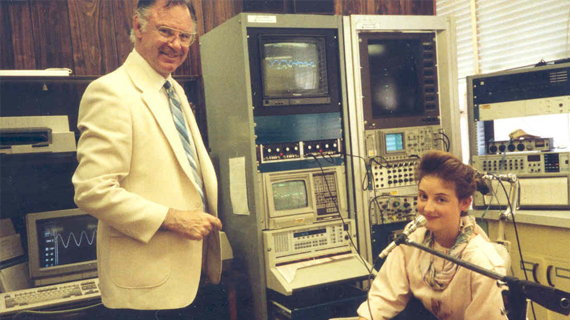
Part-time and non-tenure track faculty made valuable contributions to the department. These people made a real difference. Gayle Sallee provided excellent supervision of speech pathologists as they pursued teaching credentials in the public school systems. With credentials, they could function as traditional speech pathologists in the model of conducting therapy with children in groups or individually, but they also could assume classroom teacher roles in classrooms of diagnosed communication handicapped youngsters. As a Lecturer, Sallee also supervised student clinicians in the SDSU clinic.
Nancy Charters, Ph.D. supervised and lectured in the department, also, during the late 70s. Patricia Launer (Pat), soon to complete her Ph.D., joined the faculty as a Lecturer in 1983. She possessed a rich background in the area of language and communication. Li-Rong “Lilly” Cheng brought an international perspective to the department with her expertise in cross cultural language. Ruby Frank and Marlowe Fischer supervised clinical practica and lectured in introductory courses, proving to be effective with undergraduate students and those involved in student teaching. The American Sign Language course remained one of the most popular courses on campus, later to be accepted by the faculty Senate as meeting the foreign language requirement for graduation. Some other part-time Lecturers during the 1980s were Kathleen Hoffer, referred to earlier, Marcelle Bennett-Richardson, who was a full-time Speech-language Pathologist in the Cajon Valley Unified School District and Kathleen Kramer. Dr. Judith Scheinberg taught her first class (psychoacoustics) in 1978 and continued teaching and supervising in audiology for several years. When she returned to California in 1991, she resumed her active role with audiology until 1991. Jacqueline Adler also made numerous contributions, supervising both diagnostic and rehabilitation practica in the audiology clinic. Claudia Dunaway was another successful public school Speech-Language Pathologist who supervised clinicians at San Diego State. In 2010, she was awarded the prestigious Monty Award as outstanding Alumna of the College of Health and Human Services. In the previous year, Dunaway had been recognized nationally by the American Speech-Language-Hearing Association with the important Roland Van Hattum award. This information will be covered in Part III of this history. The 80s saw the addition to the faculty including Barry Jones, Ph.D., Linda Rowe, Ph.D., Janis Schumacher and Carol Woolf.
The 70s and 80s saw huge advances in diagnostic tools and treatment strategies in the field. No longer were clinicians working exclusively with traditional disorders of articulation, voice, stuttering, and language development, they were also relied upon for expertise in swallowing (dysphagia), cluttering, areas of language classified as pragmatics, memory deficits, and communication status associated with a wide range of neurological impairments. Knowledge was wider and more precise and methods of treatment more focused. During Harriett Kopp’s tenure as Chair of the Department of Speech Pathology and Audiology (aka Communicative Disorders), she was admitted to the National Academy of Sciences, a highly prestigious honor.
Beverly Wulfeck, a part-time clinical supervisor during the 1970s, completed her Doctorate in Psychology at UCSD in the 1980s, while she served as the Director of the Clinical Training Center. She was recruited to join the faculty in 1994 as a tenured professor to become the Director of the Ph.D. program with UCSD and leading to her assumption of the present Director role in the School of Speech, Language, and Hearing Sciences currently. Marilyn Newhoff, Ph.D. was hired in 1978, and her area of expertise was language. A clinician and researcher, her research led to numerous important publications in the field of language, particularly the pragmatics of language. She left SDSU within the next decade, but returned in 2001 as the newly hired Chair of the Department of Communicative Disorders. Following several successful years in that post, she was appointed Dean of the College of Health and Human Services. The period, during which Dr. Newhoff provided administrative guidance of the college from 2001 to the present (2013), will form the third and final chapter of this written history.
1984
Barbara Hodson, Ph.D., arrived on campus in 1984 and brought with her a fresh and scientifically based approach to articulation remediation in children. Already a published researcher and clinician, she continued to research and produce data regarding articulation at an astonishing pace. In 2010, she received Honors from the American Speech Hearing Association, as did Dr. Marilyn Newhoff. Drs. Newhoff and Hodson became nationally recognized experts in their fields of language and articulation and were in great demand as speakers and trainers across the country. Their contributions will be further discussed in Part III of this history. Dr. Alan Nichols, who first became a faculty member in 1964, continued to teach classes and clinically instruct in his areas of specialty, voice, articulation and laryngectomy. He was a careful researcher and successfully led Masters’ committees.
Since Dr. Harriett Kopp assumed the role of Acting Dean of the College of Health and Human Services from 1980-82, a series of Chairs and Acting Chairs (Sadanand Singh, Ph.D., Robert Novak, Ph.D.) of Communicative Disorders directed the department until Dr. Michael Seitz was recruited to the job in 1985. Since this section concludes with the academic year 1984-85, after the retirement of Dr. Kopp, Dr. Seitz’ involvement in the department will be addressed in Part III of this history. During Dr. Kopp’s tenure as Chair of the department of Communicative Disorders, there was strong pursuit of a joint Doctorate with UCSD. There were ongoing meetings and negotiations with faculty and administrators at both institutions, as well as with the Chancellors of the University of California and the California State University and College systems. Overall, progress was made, though setbacks along the way were encountered. Dr. Kopp emphasized faculty collegiality, a strong clinical training program, and academic research.
There were handy new speech hardware and software available for therapy. Just as technology enabled alternative communication devices for those unable to speak, there were other helpful machines available for instruction. One favorite was the Language Master, primitive seeming now, but welcomed and used a great deal during the 70s and 80s. The Language Master allowed clients to work on speech and language tasks by themselves. They could practice as much as they liked when not in a therapy session. People with aphasia (those with disorders of language symbolization) particularly benefited from utilization of the Language Master. It allowed clients to slide programmed speech and language cards (spoken and printed words, phrases and sentences) through a machine and then verbally imitate what was heard. The printed words matched the spoken words, and, with practice, hopefully, the client utterance matched the first two. Thus, the Language Master allowed unlimited self-drill away from therapy sessions. There was immediate feedback from the machine.
1985
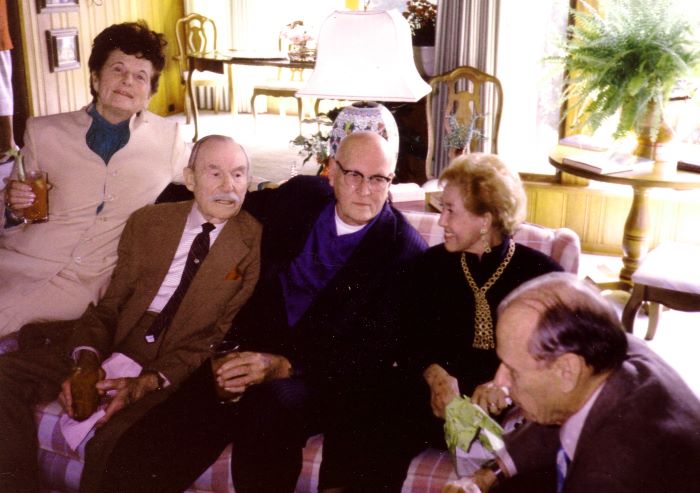 Open the image full screen.
Open the image full screen.
What is the most striking development in the arc of the SSLHS evolution from 1925 until 1985 is the steady move toward science based therapy. Science based research came naturally, but the results of science now fueled approaches to therapy. Certainly, Travis, Van Riper and others applied scientific methods to prove their hypotheses even in the 1930s, 40s and 50s, but many of the models for speech correction and speech therapy until the mid-1970s were educational ones. By 1985, clients and clinicians were monitoring speech and vocal patterns on spectrographic machines, and severely communicatively challenged individuals were making their needs known through alternative communicative devices. Speech could now be programmed on rather primitive mechanical speech machines to enable students to understand the phonological components of speech: implosion, explosion, voicing, non-voicing, assimilation, nasality, denasality, etc. were demonstrated via scientific inventions, and were plainly visible for all researchers, students, clients and families. Master’s theses findings were more rigorously scientifically grounded as the school matured. In fact, due to recruitment of outstanding faculty and graduate students who were thoroughly trained in scientific inquiry, the school was poised in 1985 to take a giant leap forward. The huge growth spurt would bring rewards in greatly expanded numbers of grants, awards, and publications. Additionally, SSLHS would develop doctoral programs. The school offers opportunities for international studies in the field in many countries. With this in mind, the next chapter, 1986- 2012 will reveal high energy activity of a school that, by 2006, achieved outstanding rankings among speech, language, hearing graduate schools in the United States.
. .
- Written notes of Dr. Sue Earnest
- Author’s personal recollections
- Starr, Raymond, SAN DIEGO STATE UNIVERSITY A History in Word and Image
- Op. Cit., Sue Earnest’s notes
- Op. Cit, Raymond Starr, p.154; SDSU Library Special Collections; author’s personal recollection
- Ibid. Author taught sections of Oral Communication SP 103 at the time as part of her Graduate Teaching Assistant duties
- Dr. Sue Earnest’s paper ephemera
- Op. Cit., Dr. Earnest’s notes
- Ibid.
- Ibid.
- Interview of Jo Cormier 06/25/11
- Author’s recollection
- SDSU course catalogs—hiring and retirement dates of faculty from catalogs
- San Diego Union, March 20, 1966, pp. D-1& 9
- Series of interviews with Robert Lee in 2010
- Starr, Raymond, Op. Cit., p. 156
- Op. Cit., Dr. Sue Earnest’s notes
- Op. Cit., Raymond Starr, p. 183
- Heard, Lucille, unpublished paper for Zeta Rho study group
- Notes of Dr. Earnest, binder with supporting materials in SDSU Library Special Collections; author’s recollections; Op. Cit. interview of Jo Cormier
- San Diego Naval reserve news, 1972, p. 3, n.d.
- Balboa Naval Hospital Speech and Hearing Clinic binder at SDSU Library Special Collections; video interview of Dr. Sue Earnest by Fred Lewis in the Sue Earnest collection at SDSU Library Special Collections, Part of “Heart of San Diego” series
- Op. Cit., Heard, Lucille; San Diego Union, April 05, 1973, p. A-24
- LINKAGE, Spring 1999, p. 1, College of Health and Human Services
- Department of Consumer Affairs publication Speech Pathology and Audiology Examining Committee, Medical Board of California, 1990
- Op. Cit., Starr, Raymond, p. 187
- A Monty Award is given annually to an outstanding alumnus/alumna from CHHS; Among other Alumnus Monty recipients over the years have been Dr. John Saxman, Dr. Jon Miller and Dr. Donald Morgan. A Monty Award from CHHS is also awarded to an outstanding faculty member annually. The complete list of past CHHS Alumni and Faculty Monty awardees since 1972 (including many of our own) may be found on the CHHS website.
- San Diego Union, April 06, 1975, pp. D-1 and D-2
- San Diego Union, pp. D-1 and D-2, n.d. 1975
- Author’s recollections
- Various HCOP printed materials
- Op. Cit., Starr, Raymond, p. 207
Images of Dr. Edmund Thile and President John F. Kennedy at SDSC 1963 Commencement Courtesy of SDSU Special Collections; Snapshots of Dr. Paul Pfaff, Dr. Lee Travis, Mrs. Travis, Dr. Sue Earnest, Dr. John Ackley, Nancy Reed, Hunton Sellman, and Dr. Elizabeth Allen Courtesy of Dr. Sue Earnest, Pat Earnest, and Nancy Reed Gibson, now in SDSU Special Collections; Photos of Early Clinic Equipment and Dr. Alan Nichols with Student Courtesy of of SDSU School of Speech, Language, & Hearing; Dr. Kopp and Faculty Photo Courtesy of Darlene Gould Davies; Dr. Li-Rong “Lilly” Cheng image and video clip for classroom use from former SDSU Media and Technology Center
Part II Photo Gallery contains all of the images cited here and others not included with the text. Additional images in the Photo Gallery were provided by the School of Speech, Language, & Hearing Sciences, with the exception of the Riedmans photo, Courtesy of Darlene Gould Davies; and images of Cleavon Little, and of Naval Hospital, Courtesy of SDSU Special Collections
Contact Us
SDSU Speech Language and Hearing
San Diego, CA 92182-1518
